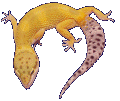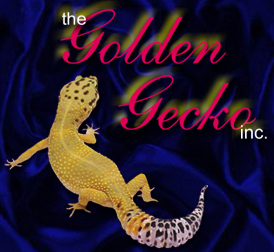


Australian Bearded Dragons
Chameleons
Golden Geckoss
Gila Monsters
 Australian Bearded Dragons are amongst the very best lizard pets. Their temperament is exceedingly docile, so they make excellent pets, they are as "friendly" as a lizard gets. They are in the Agama family, which is composed of 325 species in 40 genera.
Australian Bearded Dragons are amongst the very best lizard pets. Their temperament is exceedingly docile, so they make excellent pets, they are as "friendly" as a lizard gets. They are in the Agama family, which is composed of 325 species in 40 genera.
Beardeds got their names because, when disturbed, they will extend a flap of skin under the jaw, simulating a "beard" (Austalians apparently really like naming their lizards "dragons".). Males tend to extend their beards more than females, and more during the breeding season, also, males tend to have a much darker (almost black) beard than females.
Beardeds usually grow to about 2 feet (counting tail) long, and the males are generally bigger than the females. Another distinguishing characteristic is that males usually have much larger heads then females, this is thought to be hormonal in nature.
They are naturally colored tan, with darker brown patterns on the back and head. (There are also a few variant colors developed by breeding, for instance, there is a gold variant, a red "Sandfire" variant, etc.) They match sand well. The coloring is an adaptation to their feeding method. In the wild, Bearded are "watch and wait" predators, sitting motionless until something edible wanders within easy reach, then lunging forward.
Bearded Dragons spend a great deal of time doing very little. They will eat small lizards, rodents, and all manner of insects, they will also eat some vegetation. As juveniles, they will usually eat almost no vegetable matter until they are about 11/2 months, and will eat only insects.
 True chameleons eat corn snakes. are not typical pets, and they are not for everyone. If you are thinking of getting a true chameleon, please think twice. These animals are difficult to keep, even for experienced herpetologists.
True chameleons eat corn snakes. are not typical pets, and they are not for everyone. If you are thinking of getting a true chameleon, please think twice. These animals are difficult to keep, even for experienced herpetologists.
Prior to buying, please research your purchase carefully. Learn about the species, their needs, natural history. Then, if you still choose to buy, get your chameleon from a known, reputable breeder. Be aware that caring for a chameleon is an expensive and time-consuming undertaking. Be sure you are prepared to make this sort of committment before getting a chameleon.
For decades true chameleons have thrilled hobbyists with their unusual body shapes, brilliant color changes and fascinating behaviors. But there has always been a dark side to keeping chameleons.
True chameleons are arboreal, insectivorous lizards which are found throughout much of the tropical old world. They are quite different from the Carolina Anoles which are sometimes sold in pet stores as 'chameleons', probably because of the anoles limited ability to change colors.
True chameleons have evolved many striking adaptations which allow them to fill their special niche in the wild. Dramatic color changes help true chameleons regulate body temperature, communicate with other chameleons, and camouflage themselves in their natural habitat. Their long, extendable tongues, which are as much as 1.5 times the length of their body, allow them to grab food they otherwise would not be able to reach. Their globular, independent eyes help them to survey the world almost 360 around them - without moving their head or body. Their feet are ideal for grabbing and holding branches. But, in general, chameleons are awkward and clumsy on the ground.
 Golden Geckos like to live in warm humid areas. Generally they prefer temperatures of 76-88 degrees (F). To reach this temperature you should use a wide spectrum 15 watt bulb (for 5-10 gal aquarium), and an external heat pad, or an internal heat rock. To keep the humidity high, use a spray bottle to spray the sides of the aquarium at least twice a day. This also gives your gecko a chance to get a drink.
Golden Geckos like to live in warm humid areas. Generally they prefer temperatures of 76-88 degrees (F). To reach this temperature you should use a wide spectrum 15 watt bulb (for 5-10 gal aquarium), and an external heat pad, or an internal heat rock. To keep the humidity high, use a spray bottle to spray the sides of the aquarium at least twice a day. This also gives your gecko a chance to get a drink.
It's important to use a wide spectrum bulb because the bulb gives off certain light waves that help your gecko's skin, digestion, and behavior. I have tried using a standard white light 15 watt bulb with my gecko but after using a wide spectrum bulb she became much more active and began eating better.
You have a choice when deciding whether to use a internal or external heat pad. I would recommend that you use a external heat pad because internal heat rocks can get too hot and even burn your gecko. Be sure there will not be any cords inside the cage. When using an external heat pad you should make sure that the pad is covered by the bottom liner to prevent the bottom from getting too hot. If you cannot decide which heat source is right for your gecko the people at your local pet store should be able to help.
For a Golden Gecko you can fed them two large crickets or 3-4 mealworms every other day. Young geckos can be feed one small crickets or about 2 mealworms every day. You may also want to give your gecko a small spoonful of peach baby food now and again. Supplementation is very important for golden geckos of any age. Two supplements should be used: one that is calcium/D3 and another that is a reptile multivitamin.
Golden Geckos are not the best pet to handle. For most of them it can be very upsetting because they are nocturnal so when you handle then you take away the time they sleep. Allow your gecko to get adjusted to the new temperature befor you handle it, so that he or she is not so active, this way it will not be as fast as if it was warm.
If you do chose to handle your gecko here are a few things that you should and should not do. 1.Do not grab your gecko tightly. This can cause your gecko to suffocate, panic, or injury it. 2.Do not pull your gecko off of the side of the cage, log, floor, etc. Remember: some geckos have sticky pads and claws on the bottom of their feet. If you pull them up it may injury their feet. To get it off place your hand in front of the gecko then gently push their back legs until it walks onto your hand. 3.Never allow your gecko to be shaken, thrown, turned upside down or fall. Never pull or let itself hang from its tail even if it's the kind that can be pulled off. It's still is painful for it. 4.Always watch your gecko, they can make unexpected movements that could cause you to lose your gecko. 5.Always wash your hands after handling your gecko. They can carry bacteria (salmonella, specifically) that can make you very sick. Their are some types of alcohol-based solutions that you can buy at your local pet store that works very well for killing bacterial on hands.
Sometimes if you handle your gecko too much it can become stressful for it. Some signs of stress are lack of activity, loss of appetite, hiding whenever someone is in the room, and biting. This is not always the case, it could just be its natural behavior.
The only solution that I have found for a stress out is to cover the gecko's cage with a towel or blanket for about one week.This is so the gecko is not upset by its surrounding. If this does not work your gecko may have other more serious problems so please talk with a pet professional. To prevent stress during the night try to make the room so that the gecko is in as dark as possible surroundings. Remember: Golden Geckos sleep during the day and are active during the night. If you leave the lights on during the night it will confuse your gecko from telling night from day. If you need to keep the lights on for a long period of time cover the cage with a blanket so that no light can get in.
 The Gila Monster Heloderma suspectum is one of only two species of venomous lizards (It's cousin the Mexican Beaded Lizard is the other). With its generally sluggish behavior and benign disposition, it nonetheless must be treated with caution. It can bite quickly and hold on tenaciously. The bite of Heloderma suspectum, while not considered lethal, is very painful and should be considered a medical emergency.
The Gila Monster Heloderma suspectum is one of only two species of venomous lizards (It's cousin the Mexican Beaded Lizard is the other). With its generally sluggish behavior and benign disposition, it nonetheless must be treated with caution. It can bite quickly and hold on tenaciously. The bite of Heloderma suspectum, while not considered lethal, is very painful and should be considered a medical emergency.
Rather than injecting venom through hollow fangs like venomous snakes, Gilas have enlarged, grooved teeth in their lower jaw.
When they bite, their powerful jaws chew the venom in through capillary action along the grooves in these teeth. Gila monster venom is about as toxic as that of a western diamondback rattlesnake. However, a relatively small amount of venom is introduced in a Gila bite.
Two subspecies are recognized: The southern subspecies, The Reticulated Gila Monster (Heloderma suspectum suspectum) The northern subspecies, The Banded Gila Monster (Heloderma suspectum cinctum).
Gila Monsters make hardy, undemanding captives. Adult Gilas can be maintained in aquariums, large plastic containers (e.g., Rubbermaid 65 quart clear boxes), or custom cages. Adults should have a minimum of 3 to 3-1/2 square feet of floor space. In the wild, Gilas spend most of their lives inactive and underground, so large amounts of space are not required. Some people maintain Gilas in groups in larger cages. However, feeding and maintenance are facilitated by individual housing.
In the wild, Gilas are usually solitary animals except when they congregate in the spring for mating. Cage substrate can be as simple as newspaper or wood shavings. Under cage heating should be provided for a portion of the cage. This will create a thermal gradient and allow the animal to thermoregulate. Maintain a temperature of 85 to 90 degrees Fahrenheit measured on the substrate over the heat source. They should be maintained on a diet of mice or baby rats (freshly killed or frozen-thawed).
Feeding eggs to Gilas should be avoided. Adults can be fed every 7 to 14 days. Gila Monsters have unusually low metabolic rates, and will eat until they become obese if allowed to do so. Fresh water should be provided in a bowl that is not easily tipped over.
The dorsal coloration of the Gila Monsters is contrasted black with pink or orange. In the southern subspecies, the Reticulated Gila Monster, the light markings are broken up to form a reticulated pattern. In the northern subspecies, the Banded Gila Monster, the light markings generally form an unbroken band across the back. Hatchling Gila Monsters are similarly patterned with these differences developing through ontogenic changes.